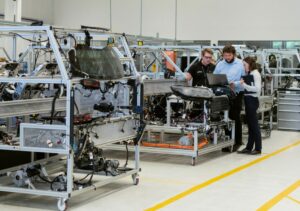As we approach the fourth industrial revolution, hyper-connectivity and 5G is set to revolutionise manufacturing sector. Mysore Madhusudhan, Executive Vice President – Collaboration and Connected Solutions, Tata Communications shares some key insights that manufacturers can use to empower businesses with 5G for successful transformation.
Since the dawn of the internet, the world as we knew it transformed to become a global village. We don’t depend on letters which take weeks to arrive at its destination or go to call centres to make international calls. With a few taps on a keyboard, we can send emails to connect with family or business partners across the globe instantly.
 This evolution of connectivity also had a great impact in major industries and is set to continue as we move into Industry 4.0. The fourth industrial revolution is transforming business operations for the better and we’re only at its cusp.
This evolution of connectivity also had a great impact in major industries and is set to continue as we move into Industry 4.0. The fourth industrial revolution is transforming business operations for the better and we’re only at its cusp.
There’s been a lot of talk about connected factories and how they can revolutionise manufacturing while levelling up the roles of humans. But, although the potential is real, it’s also true that most manufacturers don’t know where to begin.
It’s currently a watch-and-learn moment for them as only large enterprises are able to take on the risks of trialling new technologies. With this in mind, here are some key insights that manufacturers of all sizes can take away on the subject.
A new age
“We’re currently in an age of hyper-connectivity and 5G will be the fuel to propel smart factories of the future.”
Factories of the future must consist of man, machine, and material working seamlessly together to create a diverse ecosystem of ‘connected things’.
Man: This consists of solutions that place people at the centre of digital transformation to achieve business goals such as improving employee safety and productivity by using augmented and virtual reality (AR/VR) solutions for remote monitoring and quality assurance.
Machine: This consists of solutions that place operational equipment at the centre of digital transformation to achieve business goals such as predictive maintenance to ensure zero unplanned downtime.
Material: This consists of solutions that place the raw material at the centre of digital transformation to achieve business goals such as improving cycle time by monitoring the precise input of resources.
Factories of the future
“When planning digital transformation projects for factories, manufacturing leaders must go beyond the first three Ms (man, machine, and material), to also include two new Ms – method and market – to unlock the full potential of a 5G-enabled smart factory.”
 Method: This concerns the new ways of achieving business goals which will give rise to new revenue models that will unlock and create value.
Method: This concerns the new ways of achieving business goals which will give rise to new revenue models that will unlock and create value.
Market: In this process, the latest methods of operation will enable enterprises to address new systems or markets making use of new revenue models.
An ecosystem with all 5 Ms will transform the enterprise to not only achieve current business goals, but also unlock new revenue sources, business models, and the ability to address new markets through secure digital experiences.
The 5G – IoT journey
“The Internet of Things (IoT) is a key enabler of digital transformation for factories of the future.”
To truly transform, enterprises will have to do more than just provide IoT connected devices.
The digital transformation journey will have to be business-outcome focused and will require a revamped business strategy that’s enabled by the right set of technology and solution providers.
The key elements that will enable the 5 Ms and IoT in the 5G era are:
- Network: This is the core communication layer that will deliver low latency services across licensed or unlicensed bands.
- Devices: IoT-enabled devices can be used for location-specific services, two-way alerts, remote configuration, monitoring, and maintenance.
- Platform: Driven by technology, device, and access neutral, it will be capable of supporting multiple industry use cases.
- Applications: The Tata Communications MOVE™ platform is supported by more than 150 APIs for ease of integration with third party enterprise applications.
- Analytics-based insights: For providing outcome driven and business focussed insights to make informed decisions.
- Security: This is most important as the world continues to become more connected. Enterprises will need a provider with a multi-layered approach to security.
 The move from automation to 5G-enabled hyper-connectivity is going to heavily influence the entire value chain and will invariably affect how organisations do business.
The move from automation to 5G-enabled hyper-connectivity is going to heavily influence the entire value chain and will invariably affect how organisations do business.
“To successfully transform, manufacturing leaders must consider using the right technology, the right partner, flexible modules, and the ability to receive a return in investment, sooner rather than later.”
We’ve also written more about how our platform can help industries such as automotive, manufacturing, and healthcare to digitally transform. So, click here for a deep-dive on how Tata Communications can transform your enterprise with 5G-enabled IoT.
Transformational Hybrid SolutionsOur cloud-enablement services offer the best performance on your traffic-heavy websites or mission-critical applications.
Core NetworksTata Communications™ global IT infrastructure and fibre network delivers the resources you need, when and where you need them.
Network Resources
Unified Communications As A ServiceBreak the barriers of borders efficiently and increase productivity with Tata Communications’ UC&C solutions.
Global SIP ConnectEmpower your business with our SIP network and witness it grow exponentially.
InstaCC™ - Contact Centre As A ServiceCloud contact centre solutions for digital customers experience and agent productivity.
DIGO – Communications Platform as a ServiceDIGO is an in-network cloud communications platform, enabling you to power up converged contextual human-to-everything conversations globally.
Unified Communication Resources Case studies, industry papers and other interesting content to help you explore our unified communications solution better.
IoT SolutionsThe Internet of Things is transforming the way we experience the world around us for good. Find out more about our Internet Of Things related solutions here.
Mobility SolutionsTata Communications’ mobility services enable your enterprise to maintain seamless communication across borders, with complete visibility of cost and usage.
Mobility & IoT Resources
Multi-Cloud SolutionsWith enterprises transitioning to a hybrid multi-cloud infrastructure, getting the right deployment model that yields ROI can be a daunting task.
Cloud ComplianceCompliant with data privacy standards across different countries and is also designed to protect customers’ privacy at all levels.
IZO™ Cloud Platform & ServicesIZO™ is a flexible, one-stop cloud enablement platform designed to help you navigate complexity for more agile business performance.
Managed Infrastructure ServicesIntegrated with our integrated Tier-1 network to help your business grow efficiently across borders.
Cloud PartnersWe support a global ecosystem for seamless, secure connectivity to multiple solutions through a single provider.
Cloud Resources
Governance, Risk, and ComplianceRisk and Threat management services to reduce security thefts across your business and improve overall efficiencies and costs.
Cloud SecurityBest-in-class security by our global secure web gateway helps provide visibility and control of users inside and outside the office.
Threat Management - SOCIndustry-leading threat-management service to minimise risk, with an efficient global solution against emerging security breaches and attacks.
Advanced Network SecurityManaged security services for a predictive and proactive range of solutions, driving visibility and context to prevent attacks.
Cyber Security ResourcesCase studies, industry papers and other interesting content to help you explore our securtiy solution better.
Hosted & Managed ServicesTata Communications provide new models for efficient wholesale carrier voice service management. With our managed hosting services make your voice business more efficient and better protected
Wholesale Voice Transport & Termination ServicesYour long-distance international voice traffic is in good hands. End-to-end, voice access & carrier services which includes voice transport and termination with a trusted, global partner.
Voice Access ServicesTata Communication’s provide solutions which take care of your carrier & voice services, from conferencing to call centre or business support applications.
Carrier Services Resources
CDN Acceleration ServicesOur CDN Web Site Acceleration (WSA) solution helps deliver static and dynamic content, guaranteeing higher performance for your website.
CDN SecuritySafeguard your website data and customers’ information by securing your website from hacks and other mala fide cyber activities.
Video CDNDeliver high-quality video content to your customers across platforms – website, app and OTT delivery.
CDN Resources
Elevate CXIncrease customer satisfaction while empowering your service team to deliver world-class customer experience and engagement.
Live Event ServicesTata Communications’ live event services help battle the share if eyeballs as on-demand video drives an explosion of diverse content available on tap for a global audience.
Media Cloud Infrastructure ServicesTata Communications’ media cloud infrastructure offers flexible storage & compute services to build custom media applications.
Global Media NetworkTata Communications’ global media network combines our expertise as a global tier-1 connectivity provider with our end-to-end media ecosystem.
Use CasesUse cases of Tata Communications’ Media Entertainment Services
Remote Production SolutionsMedia contribution, preparation and distribution are highly capital-intensive for producers of live TV and video content, and their workflows are complex.
Media Cloud Ecosystem SolutionsThe Tata Communications media cloud infrastructure services offer the basic building blocks for a cloud infrastructure-as-a-service.
Global Contribution & Distribution SolutionsTata Communications’ global contribution and distribution solution is built to reduce capital outlay and grow global footprint.
Satellite Alternative SolutionsAs more and more consumers choose to cut the cord & switch to internet-based entertainment options, broadcasters are faced with capital allocation decisions.
LeadershipA look into the pillars of Tata communications who carry the torch and are living embodiment of Tata’s values and ethos.
Culture & DiversityHere at Tata Communications we are committed to creating a culture of openness, curiosity and learning. We also believe in driving an extra mile to recognize new talent and cultivate skills.
OfficesA list of Tata Communications office locations worldwide.
SustainabilityTata Communications adopts a holistic approach and harnesses the power of new-age technologies like 5G, IoT and AI to build a sustainable digital world.
FAQCheck out our FAQs section for more information.
BoardHave a look at our board of members.
ResultsFind out more about our quarterly results.
Investor PresentationsFollow our repository of investor presentations.
FilingsGet all information regarding filings of Tata communications in one place.
Investor EventsAll investor related event schedule and information at one place.
GovernanceAt Tata, we believe in following our corporate social responsibility which is why we have set up a team for corporate governance.
SharesGet a better understanding of our shares, dividends etc.
SupportGet all investor related contact information here.


